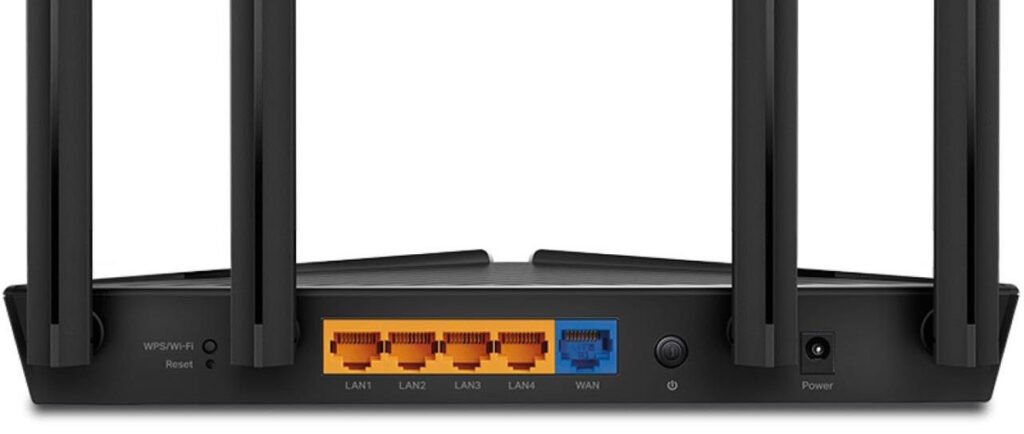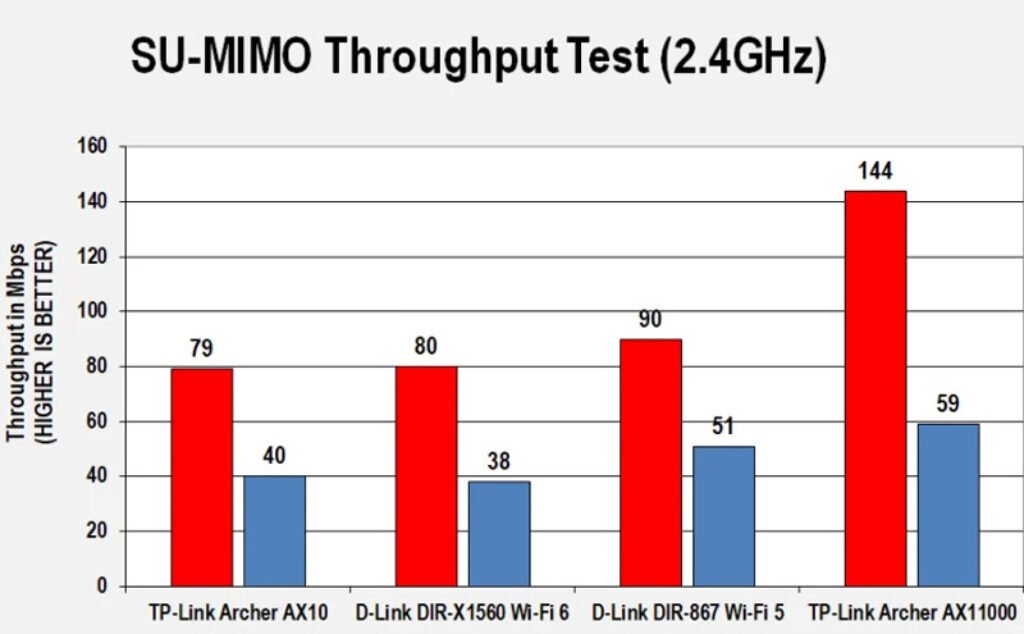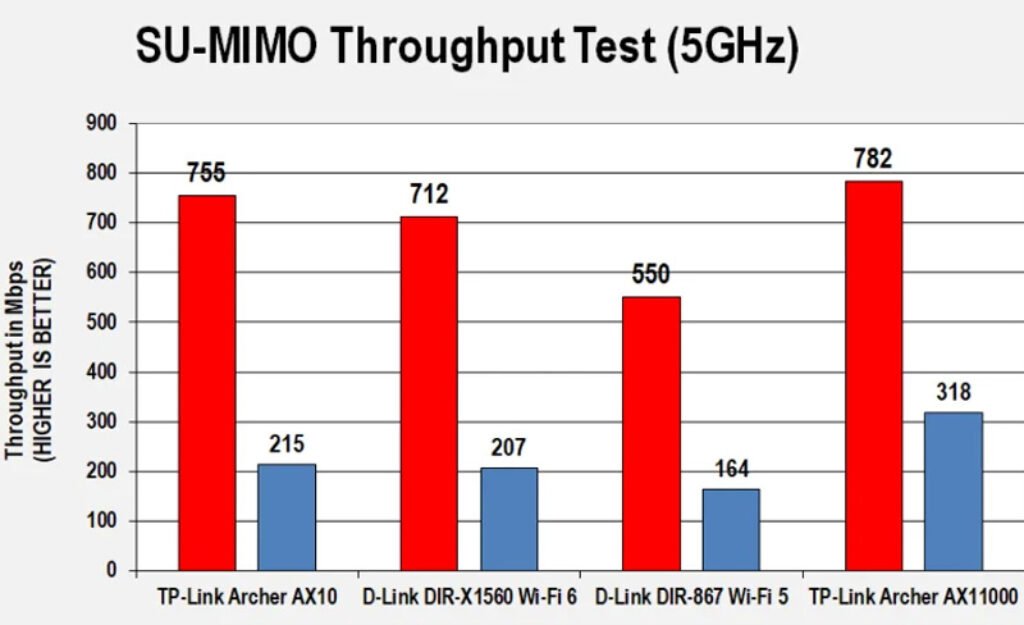The TP-Link Archer AX10 router is an affordable Wi-Fi 6 router for the masses. It delivers decent speeds, especially on the 5GHz band, and it supports TP-Link’s OneMesh technology so you can use it to build out a mesh network.

TP-Link Archer AX10 Router Pros and Cons
TP-Link Archer AX10 Router Design
Following the exterior resemblance with Archer AX50, TP-Link deployed a design language that fits the yet another dual-tone (glossy and matte black) plus textured grill and TP-Link’s logo design of Archer AX10 that I believe a good choice in the way of design this Archer AX10. Four external antennas create a reliable and efficient network along with magnetic base to be mounted fast and easy.

For those who are partial towards wired connections, the impression of ports to the bottom of the Archer AX10 includes four Gigabit Ethernet ports in addition to a WAN port for connecting to the internet. But it lacks a USB port. The front of the TP-Link Archer AX10 router has a row of LED indicator lights that report on power, both wireless bands, internet connection, Ethernet activity and WPS activity, giving at-a-glance information about power, internet and wireless activity, for quick assessment of network status.
TP-Link Archer AX10 Router Feature
- OneMesh Compatible – Create a Whole Home WiFi with your TP-Link OneMesh products RTBU-Get/Dispose- request/return ULONG_PTR -Get ULONG_PTR data and Dispose it in finally block.
- Next-gen Wi-Fi 6 Technology – With OFDMA and MU-MIMO, Archer AX10 communicates more data to more devices using the 2. Wi-Fi 6 from and and 5 GHz bands to power your smart home devices and all your high-demand applications. Ideal for high-broadband activities like streaming, gaming, and smart home connectivity.
- Next-Gen Dual Band router – 300 Mbps on 2.4 GHz (802.11n) + 1201 Mbps on 5 GHz (802.11ax)
- More devices than ever before can now simultaneously and seamlessly communicate more data to more devices using OFDMA and MU-MIMO technology, all at the same time, while using less energy and reducing the lag.
- Fast Dual-Core 900MHz Processor – Your devices all stay connected with a smooth connection and enhanced coverage. Optimizes performance of streaming, online gaming, and video content when traffic is high. More coverage and less interference: With its high-power amplifiers and Beamforming technology, the Archer AX10 lets you experience stable, lag-free Wi-Fi coverage throughout your home.
- Backward compatible: The Archer AX10 supports all previous 802.11 standards and all Wi-Fi devices
TP-Link Archer AX10 Router Specifications
TP-Link Archer AX10 is an AX1500 dual-band 4-stream router, providing extreme speed up to300Mbps on the 2.4GHz band and 1,201Mbps on the 5GHz band. It comes with a 1.5 GHz triple-core processor, 256 MB of RAM, 114 MB flash memory, and 16MB flash memory to process more data more quickly, and uses 802.11ax technology, which includes OFDMA technology (so that multiple users can share the same channel for more efficient bandwidth use) as well as TWT technology (to help reduce client power consumption), MU-MIMO simultaneous data transmission and beamforming technology which is able to direct signals straight to clients. It does not offer 160MHz channel bandwidth or WPA3 encryption, however.
| Brand | TP-Link |
| Model Name | Archer AX10 |
| Standards and Protocols | Wi-Fi 6 IEEE 802.11ax/ac/n/a 5 GHz IEEE 802.11n/b/g 2.4 GHz |
| WiFi Speeds | AX1500 5 GHz: 1201 Mbps (802.11ax) 2.4 GHz: 300 Mbps (802.11n) |
| Guest Network | 1× 5 GHz Guest Network 1× 2.4 GHz Guest Network |
| Dimensions (W×D×H) | 10.2 × 5.3 ×1.5 in (260.2 × 135.0 × 38.6 mm) |
| Special Feature | Alexa Compatible, Beamforming, Parental Control, Guest Mode, WPS, MU-MIMO, OFDMA, Access Point Mode, QoSAlexa Compatible, Beamforming, Parental Control, Guest Mode, WPS, MU-MIMO, OFDMA, Access Point Mode, QoS |
| Frequency Band Class | Dual-Band |
| Compatible Devices | Gaming Console, Personal Computer, Smartphone, Smart Television, Printer, Tablet, Security Camera, Smart ThermostatGaming Console, Personal Computer, Smartphone, Smart Television, Printer, Tablet, Security Camera, Smart Thermostat |
| Recommended Uses For Product | Gaming, Home |
| Included Components | Wi-Fi Router Archer AX10, Power Adapter, RJ45 Ethernet Cable, Quick Installation Guide |
TP-Link Archer AX10 Router Performance
In this performance test, I pitted it against the similarly priced D-Link DIR-867 and the more high-end Wi-Fi 6 gaming router TP-Link Archer AX11000. In the 2. 4GHz throughput performance In my 2.4GHz throughput no surprise here in same-room testing, the Archer AX10’s speed came in at 79Mbps, about the same with the DIR-X1560 (80Mbps) but 11Mbps slower than the DIR-867 (90Mbps). The Archer AX11000 bested them all with a speed of 144 Mbps. At 30 feet (9 meters), the Archer AX10 scored 40 Mbps, slightly edging out the DIR-X1560 (38 Mbps), but being slower than the DIR-867 (51 Mbps) and AX11000 (59 Mbps).

The Archer AX10 was impressive in the 5GHz throughput performance test. On the close-range testing, its speed was at 755Mbps — second place and well ahead of the DIR-867 and DIR-X1560. The AX11000 came out on top at 782Mbps. The AX10’s range also surpassed the DIR-867 and DIR-X1560 on the 30 foot test but didn’t manage to keep up with the AX11000.

TP-Link Archer AX10 Router Setup
The Archer AX10 also has the same installation process and network settings as other routers in TP-Link’s Archer series. From the web interface, you can set it up just like any other router by pointing your browser to its default IP address (192.168.0.1 or tplinkwifi. net) on the connected computer. Once the router is booted up for the first time, you will find the interface has a great many standard settings that most need to get a strong home network, such as dynamic DNS, port forwarding, IP reservation, and so much more. This router can themselves popularized as VPN server, too. As for Wi-Fi toggles, you can make or shape them to suit you. By using Smart Connect or naming the two bands 2 different network names. or you can just leave all settings default (automatic).




 Amazon.com
Amazon.com 



